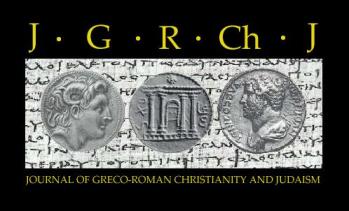9.1 | Digitizing Ancient Inscriptions and Manuscripts: Some Thoughts about the
Production of Digital Editions Christopher D. Land McMaster Divinity College, Hamilton, ON, Canada The digitization of ancient artefacts is becoming increasingly common. This
essay draws upon a hierarchy of linguistic abstractions in order to organize the
information that future scholars might wish to access in a digital edition, with the
purpose being to inform the development of encoding standards. The first two parts
of the essay introduce the digital humanities and discuss the impact of computer
technology on New Testament scholarship. A third part outlines the theoretical
distinctions that are relevant to the representation of ancient inscriptions and
manuscripts. A final part then discusses the limitations of existing editions (both
print and digital), before proposing a modular approach that would permit the
production of more comprehensive editions. |
9.2 | ‘Works of the Law’ and the Jewish Settlement in Asia Minor Barry F. Parker California Baptist University, Riverside, CA, USA This article begins with an historical study of the Jewish settlements in Asia
Minor. The religious milieu is also examined. Although it appears that the Jewish
identity remained intact, the social, cultural and religious pressures faced by
Anatolian Jews were much greater for them than for the Palestinian Jews. It is
maintained that Paul’s overriding concern in Galatians 3 is ‘faithfulness of
Christ’. To explain this, Paul adapts Anatolian concepts and language to his own
polemic. Paul’s phrase, ‘works of the law’, does not attack the law per se, but the
selective understanding of the law by the Anatolian Jews. |
9.3 | ‘Standard of Faith’ or 'Measure of Trusteeship?' A Study in Romans 12.3-A
Response Stanley E. Porter and Hughson T. Ong McMaster Divinity College, Hamilton, ON, Canada This article responds to John Goodrich’s ‘“Standard of Faith” or “Measure of a
Trusteeship”?’ published in the Catholic Biblical Quarterly (2012). Goodrich
proposes that the μέτρον πίστεως in Rom 12.3 refers to the believer’s
charism and thus should be seen as ‘a trusteeship’ God grants to each believer. We,
however, argue that the clause with μέτρον πίστεως in Rom. 12.3 should be
interpreted and translated as ‘to each God allocates his measure of faith’,
highlighting a number of significant problems in the arguments and evidence Goodrich
marshals in his article. |
9.4 | The Epistle to the Hebrews in Recent Research: Studies on the Author's Identity,
his Use of the Old Testament, and Theology Bryan R. Dyer McMaster Divinity College, Hamilton, ON, Canada The Epistle to the Hebrews has been the focus of renewed interest in New
Testament scholarship. Although it was once thought of as a neglected text in the
canon, numerous commentaries, monographs, and other studies on Hebrews have appeared
in the last decade. By examining nine monographs published between 2009 and 2012,
this article offers a state-of-play of recent Hebrews scholarship. Three areas of
interest emerge: authorship of Hebrews, its use of the Old Testament, and its
theology. This recent interest in Hebrews is to be encouraged as it has offered
fresh light on an important text from early Christianity. |
9.5 | Greco-Roman Costume and Paul’s Fraught Argument in 1 Corinthians 11.2-16 Benjamin A. Edsall Keble College, University of Oxford, Oxford, UK Using as a point of entry the scholarly debate about whether head-coverings or
hairstyles are in view in 1 Cor. 11.2–16, this article re-evaluates Paul's
surprisingly difficult argument from the perspective of Greco-Roman costume and its
attendant cultural baggage. In this light it appears that Paul is addressing what he
views as a problem of social and sexual propriety for female conduct that has arisen
from further Corinthian reflection on his own teaching. Paul's response tries to
navigate between reinforcing expected propriety while not contradicting his initial
teaching about equality in Christ. |
9.6 | Benefiting the Community through Good Works? The Economic Feasibility of Civic
Benefaction in 1 Peter Travis B. Williams Tusculum College, Greeneville, TN, USA In 1 Peter, interpreters often reject the idea that civic benefaction stands
behind the author’s instructions to ‘do good’, due in large part to the (perceived)
lack of financial resources. To this point, however, no quantitative economic data
has been produced to substantiate this claim. The purpose of this study, therefore,
is to determine whether civic benefaction would have been economically feasible for
the Petrine audience by calculating the total amount of disposable income that could
have been accumulated within the average Christian community and weighing this
amount against the known costs incurred in the practice of
euergetism. |
9.7 | The Enoch Inclusio in Jude: A New Structural Possibility Alexandra Mileto Robinson Macquarie University, Sydney, Australia This paper proposes that Jude v. 4 and vv. 14-15 function as an inclusio
framing Jude’s case against the ungodly and shaping the flow of the entire letter.
The second bracket of the inclusio, the Enoch citation (vv. 14-15), has been viewed
as one example among many in Jude’s case. Instead, it is a prophetic declaration in
light of the evidence, confirming the condemnation of the ungodly. Of all the
theophany passages at Jude’s disposal, why did he select this text to build and
finalize his charge against the ungodly? The paper offers seven suggestions why 1
En 1.9 was appropriate for Jude’s situation. |
9.8 | The Interpretation οf μέτρον πίστεως ιn Romans 12.3—Rejoinder τo Porter αnd
Ong John K. Goodrich Moody Bible Institute, Chicago, IL, USA This article responds to Stanley Porter and Hughson Ong’s criticisms of my
2012 Catholic Biblical Quarterly article on the phrase μέτρον
πίστεως (“‘Standard of Faith” or “Measure of a Trusteeship”: A Study in
Romans 12:3’). After identifying various oversights in Porter and Ong’s
argumentation, I respond to their critique in two parts, focusing initially on their
methodological claims before addressing certain alleged omissions in my earlier
piece. I thereby seek to show that my interpretation of Romans 12.3 is far more
tenable than Porter and Ong lead one to believe. |

